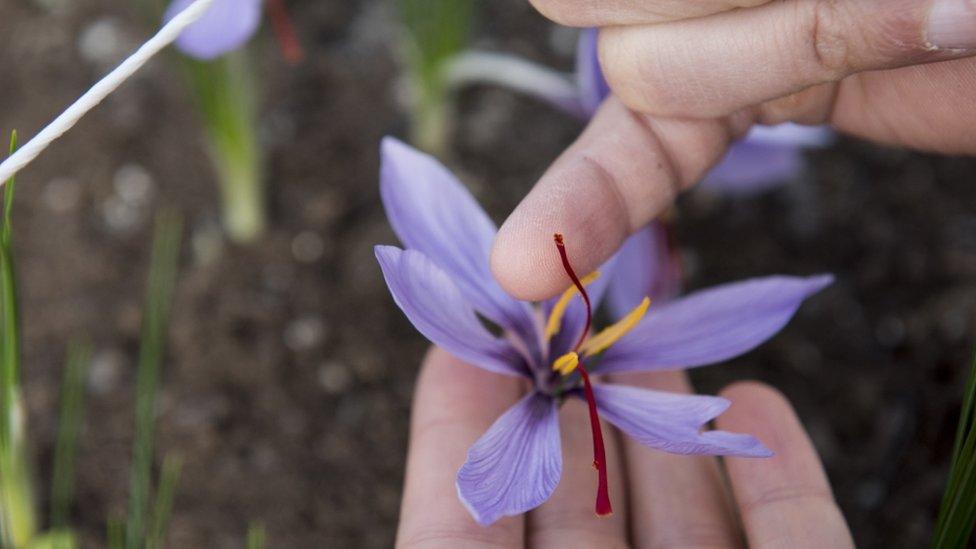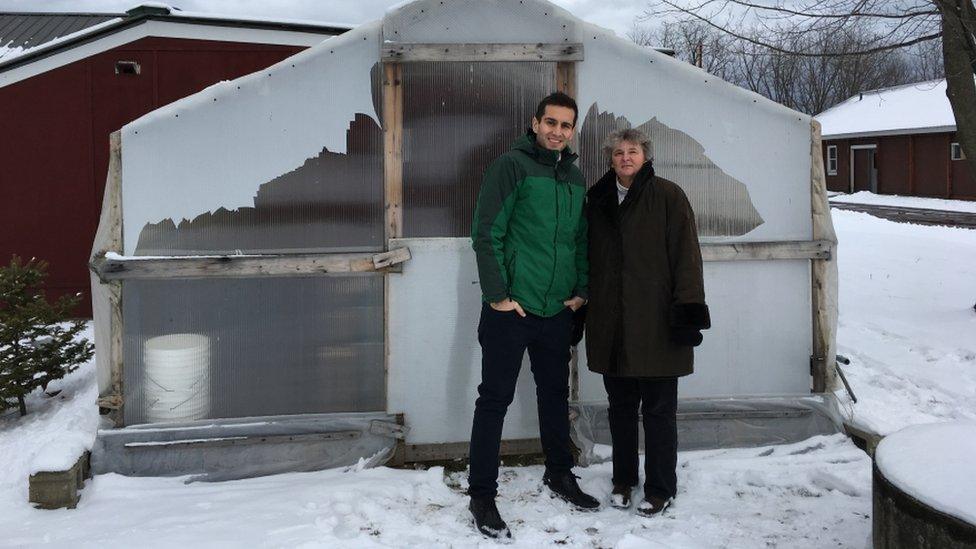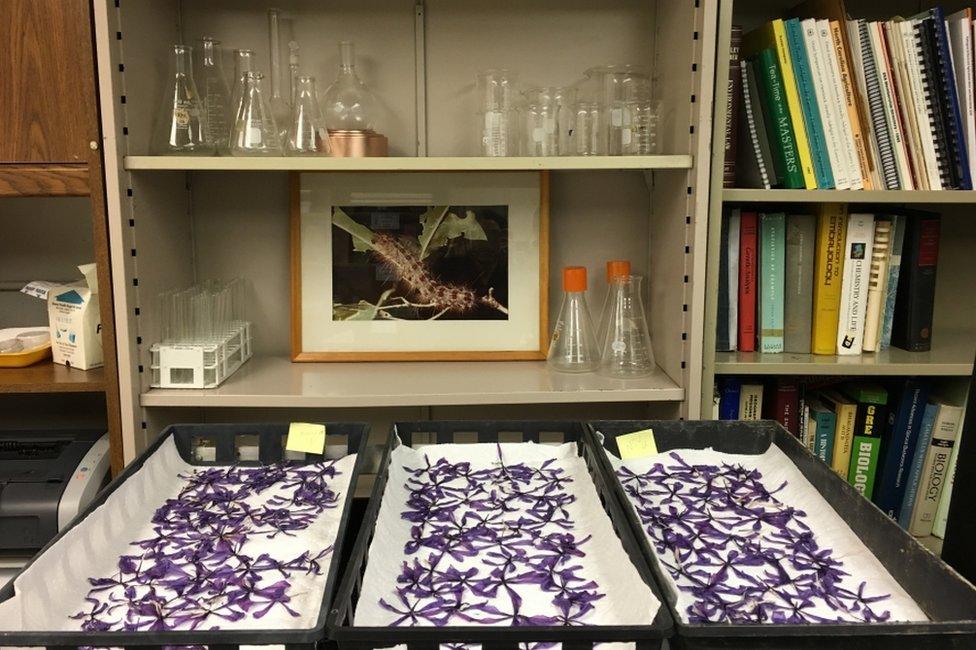Could the world's most expensive spice help farmers in Vermont?
- Published

Saffron threads are very delicate and must be picked by hand
Small farmers in the US state of Vermont are concerned traditional business won't sustain their farms, but see potential in an unlikely and very expensive spice.
The snow-covered plains of Vermont are one of the last places you'd think saffron would grow. The world's largest crops of the high-priced spice grow in Iran, Spain and Italy. Not places you'd automatically associate with heavy snowfall and bone-shattering cold weather.
But Margaret Skinner, a researcher professor at the University of Vermont, wants to bring saffron to the farmlands here.
It all started two years ago when Arash Ghalehgolabbehbahani was finishing up his doctoral studies in Mashhahd, a city in northeast Iran. The region is where about 90% of the world's saffron originates.
Ghalehgolabbehbahani's wife had been accepted to the University of Vermont and he went to the state to visit her. That's where he met Skinner.
"I know that saffron has good resistance to cold weather, so I suggested saffron to Margaret," recalls Ghalehgolabbehbahani.
That suggestion led to a research project, at the University of Vermont, where Ghalehgolabbehbahani is now a postdoctoral researcher. He and Skinner started looking into whether it would be possible to grow saffron in Vermont.
"When we started back in 2015 we had no idea … would they grow? Would we get any flowers at all? Would it be too hot? Would it be too cold?" recalls Skinner.
First they needed saffron corms, which look like bulbs - think tulip or hyacinth, but smaller. They found a local flower company which imported them from the Netherlands and picked up a few more from an elderly lady in Pennsylvania.
In fact, saffron has been grown in the US for years.

Margaret Skinner and Arash Ghalehgolabbehbahani stand next to one of their saffron pilot patches in Burlington, Vermont.
"It was very popular in Lancaster County, Pennsylvania in the late 1700s and early 1800s," explains Susan Liechty, a board member of the Herb Society of America.
"It was brought over by many, many immigrants from Spain and France and Italy and Germany," she says. "And a lot of them, especially the Germans - which is the Amish and the Mennonite that settled in Lancaster County, Pennsylvania - started growing it as a crop."
Liechty says these were small family farms. Over time, as older Mennonites and Amish farmers passed away, the number of saffron farms shrank.
"At one point I was told that there was close to 250 different farms. Now they're down to about under 50."
Today, small amounts of saffron are grown in a few parts of the US. Some is grown in California, for example, because it's home to a large Iranian community.
But what's produced in the states is dwarfed by what the country imports. Skinner sees an opportunity here for the farmers in Vermont.
They planted the saffron corms in a high tunnel, which is similar to a greenhouse but its bottom sides are open and it's not heated.
And what they found took them by surprise. "We got higher yields of saffron, in terms of the weight of saffron, than what's reported in field production in Spain or Iran," Skinner says.
Armed with her new results, Skinner asked if farmers would be interested in planting saffron as a side crop.
Some were sceptical about saffron because picking it involves a lot of labour.
Once the saffron flowers are picked, they have to be separated and the petals pulled apart.
"There's three red [...] stigmas inside each flower," Liechty says. "That's the part that you want to pick out and it has to be picked out with your fingertips. Then they have to dry."
Skinner argues that it's not much harder than making maple syrup. Plus, she says, it's something farmers can try in small quantities, alongside tomatoes and salad greens.

Julie Rubaud and her dog Sandy in one of her nine greenhouses in Hinesburg, Vermont. Rubaud will be trying out saffron as part of her herb production.
Next comes questions about marketing. Who's going to buy it? Saffron is expensive, and only a few strands can cost about $20.
But flavouring rice and risotto dishes isn't the only use for saffron. It also has potential medicinal uses. That's what interests Guido Mase, a clinician at the Burlington Herb Clinic.
"I'd be so excited to use saffron," he says.
Mase says some studies have shown that saffron helps with depression.
"There's really no-one in the country who's extracting saffron for medicinal purposes right now.
"We work with a lot of these aromatic plants, and to be able to add saffron in there as certified, organic from Vermont I think would be fantastic."
Skinner points to one more way that saffron has been put to use over the centuries: dyeing fabrics. She says one grower from the Amish-Mennonite community managed to sell some of it to Buddhist monks in Boston.
"Traditionally some monks use saffron to dye their robs and they really didn't want to buy saffron from overseas because of concerns about the politics," she says.

Saffron flowers are left to dry in the University of Vermont lab.
"So they really liked buying it locally,"
The way Vermont agricultural secretary Chuck Ross sees it, the US could see Vermont-grown saffron within the next 12 months.
Meanwhile, Skinner and Ghalehgolabbehbahani want to raise money to do more research, including on medicinal uses and ways to maximize production.
For now, saffron has created a buzz here. And who knows? Maybe the spice that some consider exotic and mysterious could bring in much-needed income for farmers in the Green Mountain state. Skinner certainly hopes so.
"I grew up in this state and I love what it stands for," she says. "Part of that is our small family farms and so I want to do what I can to sustain them."